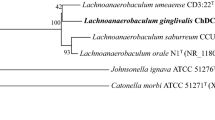Abstract
A novel Gram-negative, capnophilic, fusiform bacterium, designated strain ChDC OS43T, was isolated from a human refractory periapical abscess in the left mandibular second molar and was characterized by polyphasic taxonomic analysis. The 16S rRNA gene sequence revealed that the strain belongs to the genus Capnocytophaga, as it showed sequence similarities to Capnocytophaga ochracea ATCC 27872T (96.30%) and C. sputigena ATCC 33612T (96.16%). The prevalent fatty acids of strain ChDC OS43T were isoC15:0 (57.54%), C16:0 (5.93%), C16:0 3OH (5.72%), and C18:1 cis 9 (4.41%). The complete genome of strain ChDC OS43T was 3,412,686 bp, and the G+C content was 38.2 mol%. The average nucleotide identity (ANI) value between strain ChDC OS43T and C. ochracea ATCC 27872T or C. sputigena ATCC 33612T was >92.01%. The genome-to-genome distance (GGD) value between strain ChDC OS43T and C. ochracea ATCC 27872T or C. sputigena ATCC 33612T was 32.0 and 45.7%, respectively. Based on the results of phenotypic, chemotaxonomic, and phylogenetic analysis, strain ChDC OS43T (= KCOM 1579T = KCTC 5562T = KCCM 42841T = JCM 32133T) should be classified as the type strain of a novel species of genus Capnocytophaga, for which the name Capnocytophaga endodontalis sp. nov. is proposed.

Similar content being viewed by others

References
Chin CS, Alexander DH, Marks P, Klammer AA, Drake J, Heiner C, Clum A, Copeland A, Huddleston J, Eichler EE, Turner SW, Korlach J (2013) Nonhybrid, finished microbial genome assemblies from long-read SMRT sequencing data. Nat Methods 10:563–569. https://doi.org/10.1038/nmeth.2474
Cho E, Park SN, Shin Y, Lim YK, Paek J, Kim HK, Hwang CH, Jo E, Jin D, Chang YH, Kook JK (2015) Peptoniphilus mikwangii sp. nov., isolated from a clinical specimen of human origin. Curr Microbiol 70:260–266. https://doi.org/10.1007/s00284-014-0712-7
Felsenstein J (1985) Confidence limits on phylogenies: an approach using the bootstrap. Evolution 39:783–791
Handal T, Olsen I, Walker CB, Caugant DA (2005) Detection and characterization of beta-lactamase genes in subgingival bacteria from patients with refractory periodontitis. FEMS Microbiol Lett 242:319–324. https://doi.org/10.1016/j.femsle.2004.11.023
Kimura M (1980) A simple method for estimating evolutionary rate of base substitutions through comparative studies of nucleotide sequences. J Mol Evol 16:111–120
Kook JK, Kim MK, Kim SG (2006) Microbiological findings in refractory periapical abscess caused by endodontic treatment failure: a case report. Hosp Dent Oral-Maxillofac Surg 18:29–31
Leadbetter ER, Holt SC, Socransky SS (1979) Capnocytophaga: new genus of gram-negative gliding bacteria. I. General characteristics, taxonomic considerations and significance. Arch Microbiol 122:9–16. https://doi.org/10.1007/BF00408040
London J, Celesk RA, Kagermeier A, Johnson JL (1985) Emended description of Capnocytophaga gingivalis. Int J Syst Bacteriol 35:369–370. https://doi.org/10.1099/00207713-35-3-369
Lopez E, Raymond J, Patkai J, El Ayoubi M, Schmitz T, Moriette G, Jarreau PH (2010) Capnocytophaga species and preterm birth: case series and review of the literature. Clin Microbiol Infect 16:1539–1543. https://doi.org/10.1111/j.1469-0691.2009.03151.x
Piau C, Arvieux C, Bonnaure-Mallet M, Jolivet-Gougeon A (2013) Capnocytophaga spp. involvement in bone infections: a review. Int J Antimicrob Agents 41:509–515. https://doi.org/10.1016/j.ijantimicag.2013.03.001
Renzi F, Dol M, Raymackers A, Manfredi P, Cornelis GR (2015) Only a subset of C. canimorsus strains is dangerous for humans. Emerg Microbes Infect 4:e48. https://doi.org/10.1038/emi.2015.48. (Erratum in: Emerg Microbes Infect (2016) 5:e29)
Saitou N, Nei M (1987) The neighbor-joining method: a new method for reconstructing phylogenetic trees. Mol Biol Evol 4:406–425
Socransky SS, Holt SC, Leadbetter ER, Tanner ACR, Savitt E, Hammond BF (1979) Capnocytophaga: new genus of gram-negative gliding bacteria. III. Physiological characterization. Arch Microbiol 122:9–16. https://doi.org/10.1007/BF00408042
Stackebrandt E, Goebel BM (1994) Taxonomic note: a place for DNA–DNA reassociation and 16S rRNA sequence analysis in the present species definition in bacteriology. Int J Syst Bacteriol 44:846–849. https://doi.org/10.1099/00207713-44-4-846
Tamura K, Stecher G, Peterson D, Filipski A, Kumar S (2013) MEGA6: molecular evolutionary genetics analysis version 6.0. Mol Biol Evol 30:2725–2729. https://doi.org/10.1093/molbev/mst197
Tatusova T, DiCuccio M, Badretdin A, Chetvernin V, Nawrocki EP, Zaslavsky L, Lomsadze A, Pruitt KD, Borodovsky M, Ostell J (2016) NCBI prokaryotic genome annotation pipeline. Nucleic Acids Res 44:6614–6624. https://doi.org/10.1093/nar/gkw569
Yamamoto T, Kajiura S, Hirai Y, Watanabe T (1994) Capnocytophaga haemolytica sp. nov. and Capnocytophaga granulosa sp. nov., from human dental plaque. Int J Syst Bacteriol 44:324–329. https://doi.org/10.1099/00207713-44-2-324
Acknowledgements
This research was supported by the Bio & Medical Technology Development Program of the National Research Foundation (NRF) funded by the Ministry of Science and ICT (2017M3A9B8065844) and in part by the KRIBB Research Initiative Program funded by the Ministry of Science, ICT, and Future Planning (2013M3A9A5076603).
Author information
Authors and Affiliations
Corresponding authors
Ethics declarations
Conflict of interest
The authors declare that they have no conflicts of interest.
Additional information
Eojin Jo and Soon-Nang Park have contributed equally to this study.
Electronic supplementary material
Below is the link to the electronic supplementary material.
Rights and permissions
About this article
Cite this article
Jo, E., Park, SN., Lim, Y.K. et al. Capnocytophaga endodontalis sp. nov., Isolated from a Human Refractory Periapical Abscess. Curr Microbiol 75, 420–425 (2018). https://doi.org/10.1007/s00284-017-1397-5
Received:
Accepted:
Published:
Issue Date:
DOI: https://doi.org/10.1007/s00284-017-1397-5



